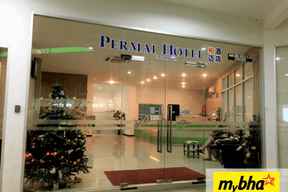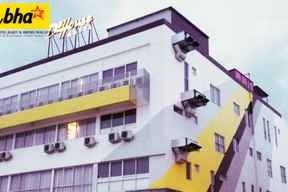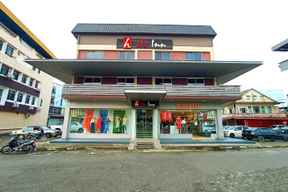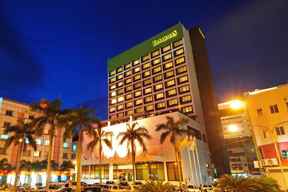
Flight From Penang (PEN) to Sibu (SBW)
Flight Information from Penang (PEN) to Sibu (SBW)
Shortest flight time
4 hr(s), 25 mins
Direct Airline from Penang to Sibu
Exclusive for new users—register today!
Code:JOMJALAN
About Sibu
Planning a trip from Penang to Sibu requires careful consideration of flight options, as these two Malaysian cities are connected primarily through connecting flights. Whether you're traveling for business or leisure, understanding the available routes, airlines, and travel times is essential for a smooth journey. This comprehensive guide provides everything you need to know about flying from Penang to Sibu, including layover options, airport information, and travel alternatives.
Direct Flights
No direct flight available.
Layover Flights
- Route: Penang (Malaysia) → Kuala Lumpur (Malaysia) → Sibu (Malaysia)
- Airlines: Batik Air
- Total Flight Duration: 10h 0m
- Aircraft: Boeing 737
- Layovers:
- Kuala Lumpur International Airport (KUL), Kuala Lumpur, Malaysia layover for 6h 55m
- Route: Penang (Malaysia) → Kuala Lumpur (Malaysia) → Sibu (Malaysia)
- Airlines: AirAsia
- Total Flight Duration: 4h 45m
- Aircraft: Airbus A320
- Layovers:
- Kuala Lumpur International Airport (KUL), Kuala Lumpur, Malaysia layover for 1h 45m
- Route: Penang (Malaysia) → Kuala Lumpur (Malaysia) → Sibu (Malaysia)
- Airlines: Malaysia Airlines
- Total Flight Duration: 4h 40m
- Aircraft: Boeing 737
- Layovers:
- Kuala Lumpur International Airport (KUL), Kuala Lumpur, Malaysia layover for 1h 35m
These are the top three layover flight options available from Penang to Sibu, showcasing a mix of airline options, total trip times, and layover durations. Each route is effectively served by either Batik Air, AirAsia, or Malaysia Airlines, featuring layovers in Kuala Lumpur.
Information about schedule and airline subject to change based on airline policy. Please check regularly at Traveloka App.
About Penang Intl - Penang
Location
Penang Intl Airport (PEN) is located approximately 16 kilometers south of Georgetown, the capital city of Penang Island. The airport is situated in Bayan Lepas, which is the main industrial area of Penang. As the third-busiest airport in Malaysia, Penang International Airport serves as a vital transportation hub for the northern region of Malaysia, connecting travelers to various domestic and international destinations.
The airport's strategic location makes it easily accessible from most parts of Penang Island, with a typical journey from Georgetown taking about 30-45 minutes by car, depending on traffic conditions. The airport is also close to the Penang Bridge, which connects the island to mainland Malaysia, making it convenient for travelers coming from other states.
Airport Terminal
Penang International Airport features a modern terminal building that underwent significant renovation and expansion in recent years to accommodate the growing number of passengers. The terminal is divided into two main areas: domestic and international, with clear signage throughout to guide travelers.
The airport operates with a single passenger terminal that handles both domestic and international flights. The terminal is well-organized with departure operations on the upper level and arrival operations on the ground level. Check-in counters are located at the front of the terminal, with dedicated areas for each airline. Security checkpoints and immigration facilities are efficiently managed to ensure smooth passenger flow.
The terminal's design incorporates elements of local culture and heritage, creating a welcoming atmosphere for travelers. With its recent upgrades, the terminal now offers improved facilities and amenities to enhance the passenger experience.
Transport to Airport
Travelers have multiple transportation options to reach Penang International Airport:
- Taxi/Ride-Hailing Services: Taxis and ride-hailing services like Grab are widely available throughout Penang. These offer the most convenient door-to-door service, with travel time from Georgetown typically taking 30-45 minutes, depending on traffic conditions. Fares generally range from RM25-RM40.
- Public Bus: Rapid Penang operates several bus routes that serve the airport, including Route 401E (Jetty-Airport), Route 102 (Teluk Bahang-Airport), and Route 401 (Weld Quay-Airport). These buses are affordable, with fares around RM2-RM4, though the journey may take longer compared to private transport.
- Airport Shuttle Services: Several hotels in Penang offer shuttle services to the airport for their guests. These should be arranged in advance with the accommodation.
- Car Rental: For those who prefer to drive, car rental services are available in Penang. The airport has designated parking areas with both short-term and long-term options.
- Private Airport Transfer: Pre-booked private transfers can be arranged through Traveloka, offering a hassle-free option for travelers who want confirmed transportation to the airport.
For travelers staying in Georgetown, the most time-efficient options are taxis or ride-hailing services, especially for early morning or late-night flights when public transportation might be limited.
Facilities
Penang International Airport offers a comprehensive range of facilities to ensure a comfortable experience for travelers:
- Dining Options: The airport features a variety of food and beverage outlets, including local Malaysian cuisine, international fast-food chains, cafes, and bakeries. These are located throughout the terminal, both before and after security checkpoints.
- Shopping: Duty-free shops selling perfumes, cosmetics, liquor, tobacco, chocolates, and local souvenirs are available in the international departure area. The domestic area also has retail shops offering books, magazines, electronics, and travel essentials.
- Lounges: Premium lounges for business class passengers and frequent flyers are available, offering comfortable seating, complimentary refreshments, Wi-Fi, and business facilities.
- Wi-Fi: Free Wi-Fi is available throughout the terminal, allowing travelers to stay connected before their flights.
- ATMs and Currency Exchange: Banking facilities, including ATMs and currency exchange counters, are conveniently located within the terminal.
- Medical Services: A medical center is available for any health emergencies or medical assistance needed by passengers.
- Prayer Rooms: Dedicated prayer rooms for Muslim travelers are provided in both the departure and arrival areas.
- Baggage Services: The airport offers baggage wrapping services, left luggage facilities, and trolleys for passenger convenience.
- Special Assistance: Services for passengers with reduced mobility or special needs are available upon request.
- Information Counters: Information desks staffed by helpful personnel are located throughout the terminal to assist travelers with queries.
The airport continually upgrades its facilities to meet international standards and enhance the overall passenger experience, making it a comfortable starting point for your journey to Sibu.
About Sibu - Sibu
Location
Sibu Airport (SBW) is strategically located approximately 23 kilometers from Sibu town center in Sarawak, East Malaysia. Situated in the central region of Sarawak, the airport serves as an important gateway to the central region of this East Malaysian state. Sibu Airport is positioned along the Igan River, providing scenic views during landing and takeoff.
The airport's location makes it accessible to not only Sibu town but also surrounding areas like Sarikei, Bintangor, and Kanowit. The distance from Sibu town center means that travelers should allocate appropriate time for airport transfers, especially during peak traffic hours or adverse weather conditions.
Airport Terminal
Sibu Airport features a modern single-terminal building that was significantly upgraded in 2012 to enhance passenger handling capacity and improve overall facilities. The terminal has a clean, functional design with separate areas for departures and arrivals.
The compact terminal is well-organized and easy to navigate. The departure hall is located on the upper level with check-in counters positioned at the front of the terminal. Security screening and departure gates are efficiently arranged to facilitate smooth passenger flow. The arrival hall is on the ground level, featuring baggage claim areas and exit points leading to ground transportation options.
Despite its relatively small size compared to major international airports, Sibu Airport efficiently handles domestic flights, particularly connections from Kuala Lumpur, Kuching, and Kota Kinabalu. The terminal's design prioritizes functionality while providing essential amenities for travelers.
Transport From Airport
Travelers arriving at Sibu Airport have several transportation options to reach the town center and other destinations:
- Taxis: Taxis are readily available outside the arrival hall. The journey to Sibu town center takes approximately 30-40 minutes, depending on traffic conditions. Fares are typically fixed at around RM35-RM45 for a one-way trip to the town center.
- Airport Shuttle Bus: While less frequent than taxis, shuttle buses operate between the airport and Sibu town, offering a more economical option. The fare is approximately RM10-RM15 per person, though schedules may be limited.
- Car Rental: Several car rental companies have counters at the airport terminal, providing options for self-drive transportation. This is convenient for travelers planning to explore the wider Sibu region and surrounding areas.
- Hotel Shuttle Services: Some hotels in Sibu offer shuttle services for their guests, which should be arranged in advance.
- Pre-booked Private Transfers: Services like Traveloka offer pre-booked private transfers that provide a hassle-free option with a driver waiting at the arrival hall.
For first-time visitors to Sibu, taxis are generally the most convenient option, offering direct transportation to your accommodation without the need to navigate public transportation systems in an unfamiliar location.
Facilities
Sibu Airport offers a range of facilities to meet the essential needs of travelers:
- Dining Options: The airport features several food and beverage outlets, including cafes and food stalls serving local Malaysian cuisine and light refreshments. These are primarily located in the public area of the terminal.
- Retail Shops: Small retail outlets offer travel essentials, local souvenirs, reading materials, and basic necessities for passengers.
- Wi-Fi: Complimentary Wi-Fi is available throughout the terminal, allowing travelers to stay connected.
- ATMs: Banking facilities including ATMs are available within the terminal building for cash withdrawals and basic banking services.
- Information Counter: A staffed information desk provides assistance to travelers with queries about flights, airport services, or local information.
- Prayer Rooms: Dedicated prayer facilities for Muslim travelers are provided within the terminal.
- Medical Services: Basic first-aid services are available for emergency situations.
- Baggage Services: Trolleys are provided free of charge for passenger convenience, and lost and found services are available.
- Special Assistance: The airport provides services for passengers with reduced mobility or special needs, which should be arranged in advance through your airline.
- Car Parking: Paid parking facilities are available for those who drive to the airport or are being picked up by private vehicles.
While Sibu Airport may not offer the extensive range of amenities found in larger international airports, it efficiently provides the essential services needed for domestic travelers, with a focus on functionality and passenger comfort.
FAQ Penang to Sibu Flight
- Question: How long does it take to fly from Penang to Sibu?
- Answer: Since there are no direct flights between Penang and Sibu, the total journey time typically ranges from 4 hours 40 minutes to 10 hours, depending on the airline and the duration of the layover in Kuala Lumpur. The fastest connections are usually around 4 hours 40 minutes with Malaysia Airlines or 4 hours 45 minutes with AirAsia when layover times are minimal.
- Question: Which airlines operate flights between Penang and Sibu?
- Answer: The main airlines operating connecting flights between Penang and Sibu are Malaysia Airlines, AirAsia, and Batik Air. Each airline offers different schedule options, with connections typically made in Kuala Lumpur. Some routes might also connect via other cities like Kuching or Kota Kinabalu, depending on the flight schedule and availability.
- Question: What is the cheapest month to fly from Penang to Sibu?
- Answer: April is generally considered the off-season for travel to Sibu, making it potentially the cheapest month to find flights. Conversely, December tends to be the peak season with higher prices. For the best deals, it's advisable to book your flights well in advance and use Traveloka's price comparison tools to track fare changes.
- Question: How far in advance should I book my flight from Penang to Sibu?
- Answer: It's recommended to book your flight at least 2-3 months in advance to secure the best prices, especially if you're traveling during peak periods like school holidays, major festivals, or year-end holidays. Last-minute bookings are typically more expensive, though occasional flash sales might offer discounted fares.
- Question: Is it possible to fly from Penang to Sibu without any layovers?
- Answer: No, there are currently no direct flights between Penang and Sibu. All flights require at least one stopover, typically in Kuala Lumpur (KUL). The flight distance between Penang and Sibu is approximately 834 miles (1,342 km), making a direct route operationally challenging for airlines.
- Question: What should I do during a long layover in Kuala Lumpur?
- Answer: For layovers exceeding 4 hours in Kuala Lumpur, consider exploring the airport's amenities which include duty-free shopping, dining options, lounges, and relaxation areas. KLIA and KLIA2 offer various entertainment options. For very long layovers (8+ hours), you might consider a quick trip to nearby attractions like Putrajaya or even central Kuala Lumpur, accessible via the KLIA Ekspres train.
- Question: What is the baggage allowance for flights between Penang and Sibu?
- Answer: Baggage allowances vary by airline and fare type. Typically, Malaysia Airlines offers 30kg for economy class, AirAsia provides options to purchase baggage allowance from 15kg to 40kg, and Batik Air generally includes 20kg for standard fares. Always check the specific allowance for your booking on Traveloka, as policies may change and differ based on your ticket type.
- Question: Are there seasonal variations in flight availability between Penang and Sibu?
- Answer: Yes, flight availability and prices can vary seasonally. During major Malaysian holidays like Chinese New Year, Hari Raya, and the year-end holiday season, flights tend to be more frequent but also more expensive and crowded. Conversely, during off-peak periods, there might be fewer flight options, but prices are generally more affordable.
Other Ways to Travel From Penang to Sibu
While flying is the most practical way to travel between Penang and Sibu due to the geographical separation (Penang being in Peninsular Malaysia and Sibu in Sarawak on the island of Borneo), there are alternative routes for travelers seeking a different experience:
- Combined Sea and Land Journey
- Route: Penang → Ferry to Butterworth → Bus/Train to Kuala Lumpur → Ferry from Port Klang to Kuching → Bus to Sibu
- Duration: Approximately 3-4 days
- Details: This adventurous route involves taking a ferry from Penang to Butterworth, then traveling by bus or train to Kuala Lumpur. From there, you would need to reach Port Klang and take a ferry service to Kuching, Sarawak. Finally, a long-distance bus connects Kuching to Sibu. This option is time-consuming but offers a unique travel experience through multiple transportation modes.
- Flight to Kuching + Bus to Sibu
- Route: Penang → Flight to Kuching → Bus to Sibu
- Duration: 1 day (3-hour flight plus 4-5 hour bus journey)
- Details: This option involves flying from Penang to Kuching (which typically has more direct flight options than Sibu), then taking a long-distance bus from Kuching to Sibu. The bus journey covers approximately 300km through the scenic countryside of Sarawak and includes several rest stops along the way.
- Flight to Bintulu + Bus to Sibu
- Route: Penang → Flight to Bintulu → Bus to Sibu
- Duration: 1 day (flight time varies plus 3-hour bus journey)
- Details: Another alternative is flying to Bintulu and then taking a bus to Sibu. The bus journey is shorter than from Kuching, making this a potentially more time-efficient option if direct flights to Bintulu are available from Penang or with a short connection.
- Private Car Charter (after flying to mainland Sarawak)
- Route: Penang → Flight to Kuching/Bintulu → Private car to Sibu
- Duration: 1 day (flight time plus 3-5 hours driving)
- Details: For more comfort and flexibility, you could fly to either Kuching or Bintulu and then arrange a private car charter to Sibu. This option costs more but provides convenience, especially for groups or families with luggage.
It's important to note that these alternative routes are significantly more time-consuming and complex compared to connecting flights. They would appeal primarily to adventure travelers who enjoy the journey as much as the destination, or those with specific reasons to stop at intermediate points. For most travelers, especially those on business trips or with limited vacation time, connecting flights via Kuala Lumpur remain the most practical option.
Explore Sibu
Popular Destinations in Sibu
- Sibu Central Market (Pasar Sibu)
Sibu Central Market stands as one of the largest indoor markets in Malaysia, spanning multiple floors filled with local produce, handicrafts, and authentic Sarawakian products. The ground floor bustles with fresh seafood, vegetables, and fruits, while the upper levels house clothing stores and food stalls. Visitors can experience the vibrant local culture while sampling indigenous foods and purchasing unique souvenirs. The market is especially lively in the morning when locals gather to purchase fresh ingredients for the day's meals.
- Sibu Heritage Centre
Located in the heart of Sibu town, this cultural museum showcases the rich heritage of the region, particularly focusing on the history of Chinese migration to Sarawak and the development of Sibu. The center houses interesting artifacts, historical photographs, and comprehensive exhibits that tell the story of how Fuzhou Chinese settlers transformed the swampy land into a thriving town. Visitors can gain deep insights into local traditions, cultural practices, and the significant contributions of various ethnic groups to Sibu's development.
- Tua Pek Kong Temple
This iconic Chinese temple, with its striking red facade and ornate decorations, stands as the oldest temple in Sibu, dating back to 1870. Located near the waterfront, the temple is dedicated to the deity Tua Pek Kong, who is believed to provide protection and prosperity. The temple features beautiful architectural elements including intricate carvings, vibrant paintings, and a seven-story pagoda that offers panoramic views of Sibu and the Rejang River. During Chinese festivals, particularly Chinese New Year and the Wang Kang Festival, the temple becomes a center of elaborate celebrations.
- Sibu Esplanade
Stretching approximately 2 kilometers along the mighty Rejang River, the Sibu Esplanade offers a scenic riverside walkway perfect for evening strolls. This beautifully landscaped promenade features exercise stations, seating areas, and observation points where visitors can watch river traffic and enjoy stunning sunsets. The esplanade is particularly popular among locals for morning exercises and evening leisure activities. Notable landmarks along the esplanade include the Swan Statue, which symbolizes the city's growth and prosperity.
- Bukit Aup Jubilee Park
Located about 10 kilometers from Sibu town center, this recreational park spans 24 hectares of lush greenery, offering a refreshing escape from the urban environment. The park features well-maintained walking trails, exercise stations, and viewing platforms that provide panoramic views of Sibu town and the surrounding landscape. The highlight of the park is the artificial lake with paddleboat rentals, making it a favorite weekend destination for families. Nature enthusiasts can also observe various species of birds and plants within the park's diverse ecosystem.
Popular Cuisine in Sibu
- Kampua Mee
Kampua Mee stands as Sibu's most iconic dish, consisting of dry noodles tossed in pork lard and shallot oil, typically served with slices of barbecued pork (char siu) and spring onions. This simple yet flavorful dish originated from the Foochow Chinese community and has become synonymous with Sibu's culinary identity. Variations include red kampua (with sweet sauce) and black kampua (with soy sauce). The best kampua can be found in local coffee shops throughout the town, with each establishment offering their unique interpretation of this beloved staple.
- Kompia
This traditional Foochow baked bread resembles a bagel but with distinctive flavors and textures unique to Sibu. The classic version features a crusty exterior with a soft, slightly chewy interior, often filled with minced meat and onions before being baked in traditional brick ovens. Modern variations include sweet fillings like kaya (coconut jam) or savory options with cheese. Kompia is traditionally enjoyed as a breakfast item or snack throughout the day and can be purchased from numerous bakeries and street vendors throughout Sibu.
- Diang Bian Hu (Soup)
This comforting rice flour soup represents a cherished element of Foochow cuisine in Sibu. The dish consists of paper-thin sheets of rice flour added to a flavorful broth made with fish, pork bones, or vegetables. It's typically garnished with minced meat, sliced fish cake, vegetables, and fried shallots. The unique preparation method involves spreading rice batter on a cloth stretched over a pot of boiling soup, creating delicate sheets that cook instantly when they touch the broth. This labor-intensive dish is particularly popular during cooler weather and family gatherings.
- Sibu Layer Cake (Kek Lapis Sibu)
While layer cakes originated in Sarawak's southern regions, Sibu has developed its own distinctive style of these colorful, intricate desserts. Sibu layer cakes feature geometric patterns and vibrant colors, requiring considerable skill to create. Made from butter, eggs, flour, and various flavorings, these cakes are baked layer by layer, resulting in impressive designs when sliced. Traditional flavors include pandan, chocolate, and prune, though contemporary bakers continuously innovate with new flavor combinations. These cakes are essential during festivals and celebrations, particularly during Hari Raya and Chinese New Year.
- Bian Ro (Wonton Soup)
This Foochow-style wonton soup features delicate dumplings filled with a mixture of minced pork, shrimp, and seasonings, served in a clear, flavorful broth. Sibu's version is distinguished by its aromatic broth and the distinctive folding technique used for the wontons. Often garnished with spring onions and fried shallots, the soup is commonly enjoyed as a light meal or starter. Many local establishments take pride in their house-made wontons, with some families guarding their recipes for generations. This dish exemplifies the refined simplicity characteristic of Foochow cuisine that has become an integral part of Sibu's food culture.
Flight Information to Sibu
Flight Duration | 4 hr(s) 25 mins |
Airport in Penang | |
Airport in Sibu |




























































